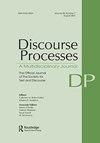锚定你的桥梁:自我解释中转述对推理的重要性
IF 2.1
2区 心理学
Q2 PSYCHOLOGY, EDUCATIONAL
引用次数: 0
摘要
摘要分析构建的回答,如思考或自我解释,可以揭示读者理解策略的宝贵信息。目前的研究通过(1)调查读者使用的理解策略的组合和模式,以及(2)研究这些模式与个体差异和理解结果的关系,对现有工作进行了扩展。我们利用三个数据集(n=472)的档案数据来研究理解策略的使用在数据集、文本和人群(高中生、本科生)中的变化。学生的自我解释被编码为策略使用,然后根据策略的组合和模式进行进一步分析。我们的分析表明,几乎所有读者都主要从事转述和/或转述和桥接的结合,很少有详细阐述的例子。此外,转述和衔接的结合是理解测试表现的最佳预测因素。就模式而言,策略之间的转换与阅读理解无关,与转述和衔接的组合呈负相关。了解哪些策略组合和模式是最佳的,可以用来提供自适应指导和反馈,从而有助于为读者提供更个性化的支持。本文章由计算机程序翻译,如有差异,请以英文原文为准。
Anchoring your bridge: the importance of paraphrasing to inference making in self-explanations
ABSTRACT Analyzing constructed responses, such as think-alouds or self-explanations, can reveal valuable information about readers’ comprehension strategies. The current study expands on the extant work by (1) investigating combinations and patterns of comprehension strategies that readers use and (2) examining the extent to which these patterns relate to individual differences and comprehension outcomes. We leveraged archival data from three datasets (n = 472) to examine how comprehension strategy use varied across datasets, texts, and populations (high school, undergraduate). Students’ self-explanations were coded for strategy use and then further analyzed in terms of combinations and patterns of strategies. Our analyses revealed that almost all readers primarily engaged in paraphrasing and/or the combination of paraphrasing and bridging, with few instances of elaboration. Further, the combination of paraphrasing and bridging was the best predictor of performance on a comprehension test. In terms of patterns, switching between strategies was not correlated to reading comprehension and was negatively correlated with the combination of paraphrasing and bridging. Understanding which strategy combinations and patterns are optimal can be used to inform adaptive instruction and feedback that can aid in more individualized support for readers.
求助全文
通过发布文献求助,成功后即可免费获取论文全文。
去求助
来源期刊

Discourse Processes
Multiple-
CiteScore
4.30
自引率
4.50%
发文量
27
期刊介绍:
Discourse Processes is a multidisciplinary journal providing a forum for cross-fertilization of ideas from diverse disciplines sharing a common interest in discourse--prose comprehension and recall, dialogue analysis, text grammar construction, computer simulation of natural language, cross-cultural comparisons of communicative competence, or related topics. The problems posed by multisentence contexts and the methods required to investigate them, although not always unique to discourse, are sufficiently distinct so as to require an organized mode of scientific interaction made possible through the journal.
 求助内容:
求助内容: 应助结果提醒方式:
应助结果提醒方式:


